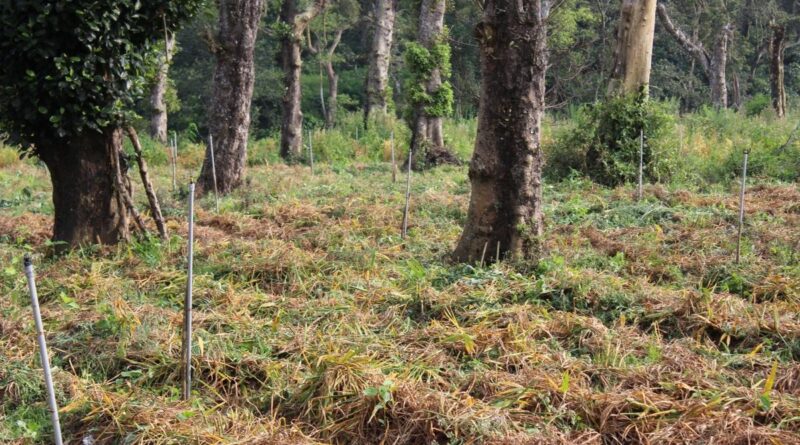Karnataka: New fungal disease affecting ginger crop in Kodagu
Once the fungal infection in ginger plants takes hold, it spreads rapidly and can cover the entire field within hours, according to researchers.
| Photo Credit: Special Arrangement
Researchers from ICAR-Indian Institute of Spices Research (IISR), Kozhikode, have identified a new fungal disease that severely affected ginger crop in 2024 in parts of Kodagu district in Karnataka.
A statement from Head, ICAR-IISR’s Regional Station at Appangala in Madikeri near here, said the disease caused by fungal pathogen Pyricularia spp. is a new threat to ginger cultivation. “While Pyricularia is well known for causing blast diseases in monocot plants like rice, wheat, and barley, this is the first time it has been reported in ginger,” the statement said.
“The disease appears as yellowing of the ginger plant leaves, accompanied by black/dark olive-green spots in the early stages. Once the infection takes hold, it spreads rapidly and can cover the entire field within hours, leading to severe crop loss and plant death,” the statement said.
Experts confirm that the rhizomes of the affected plants remain unaffected, the statement said while adding that the problems lies in the premature yellowing and drying of the leaves, which affects the proper formation of ginger rhizomes. “As a result, farmers of Kodagu have experienced losses up to 30% in rhizome weight,” said the statement.
Climatic conditions
According to researchers, the spread of the disease is largely driven by the specific climatic conditions that prevailed in Kodagu.
During August and September, the region experienced dew fall in the mornings, which provides ideal environment for the fungal pathogen to thrive and spread. “This has led to the rapid spread of the disease throughout ginger fields in some parts of Kodagu while crops in other parts of Karnataka and Kerala remain unaffected due to different environmental conditions,” the statement said.
Research conducted by the team at ICAR-IISR Kozhikode and its regional station at Appangala indicated that the climatic conditions in Kodagu – particularly the dew fall during August and September – created favourable environment for the spread of the disease.
The research team at ICAR-IISR faced significant challenges while studying the disease as samples collected were often dried by the time they reached the laboratory in Kozhikode. However, after months of investigation, scientists were able to confirm Pyricularia spp. as the cause behind the disease.
Control measures
To manage the disease, scientists have recommended the use of fungicides such as Propiconazole at 1 ml/L or a combination of Carbendazim and Mancozeb at a ratio of 2g/L.
“These fungicides can be used for the treatment of seed rhizomes for 30 min and before storage in well ventilated place. As a prophylactic measure Propiconazoleor Tebuconazole @ 1ml/L can be sprayed four months after planting. If symptoms such as black/dark olive-green pinhead spots surrounded by yellowing leaves are observed, immediate fungicide application is advised to curb the rapid spread of the disease,” the statement said.
Given the fact-acting nature of Pyricularia, it is essential for farmers to act swiftly. The disease can spread over large areas in as little as 10 hours with some affected fields located up to 20 km apart, the statement said.
Farmers, whose crops have been affected by this disease, have been advised to temporarily refrain from cultivating ginger in the affected areas. The research team is conducting further studies to better understand the pathogen’s behaviour and its environmental triggers, the statement added.
Published – February 05, 2025 07:24 pm IST

